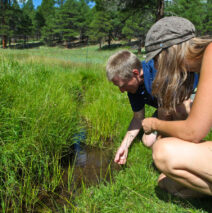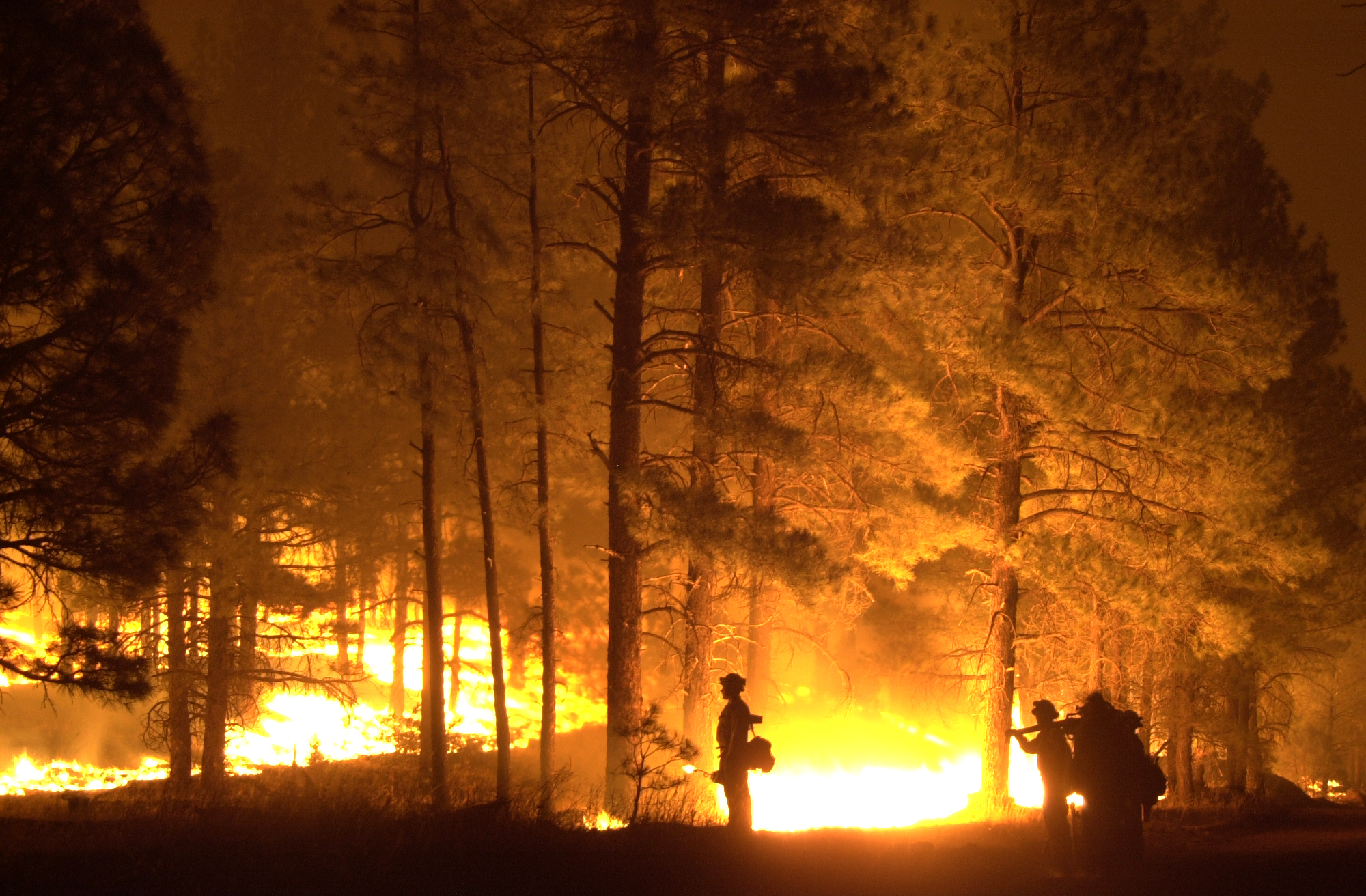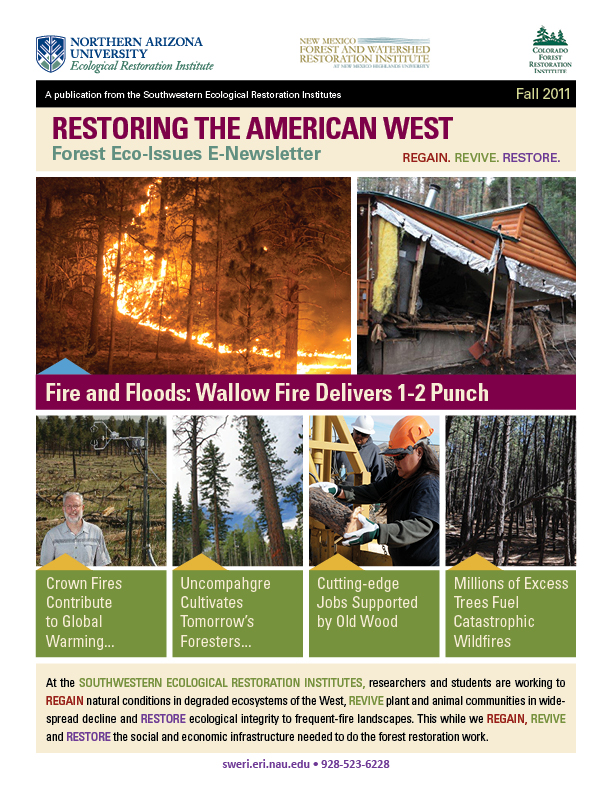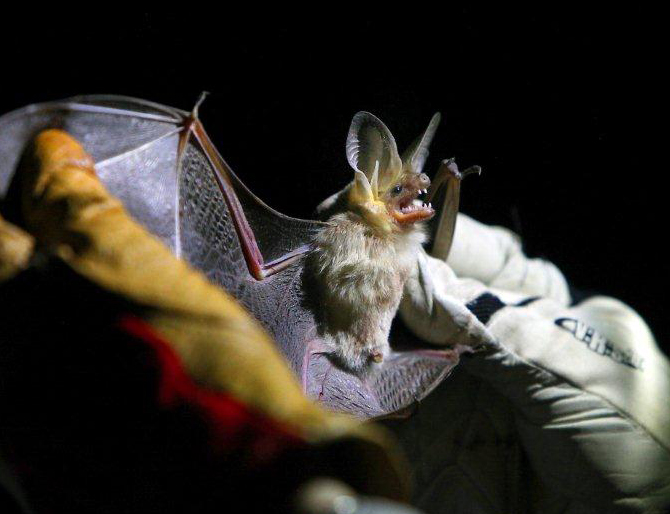SRP and NAU to Study Effects of Forest Restoration
SRP and NAU to Study Effects of Forest Restoration FLAGSTAFF, Ariz. – Scientists say Arizona’s overcrowded forests are affecting the natural processes of a healthy ecosystem. Past studies have shown that much of Arizona’s ponderosa pine forests have hundreds of trees more per acre than existed prior to 1900. This overstocking has had dramatic impacts on the hydrologic cycle, as well as related impacts to range conditions and wildlife habitat. In addition, where fire was once a welcome visitor to the forest in helping to thin trees and recycle nutrients, fire now is prone to explode into a catastrophic stand-replacing wildfire. The effects of climate change are likely only to make matters worse. To find out how the forest ecosystem responds to landscape-scale forest-restoration efforts, the Ecological Restoration Institute (ERI) at Northern Arizona University and Salt River Project (SRP) are teaming up in an unprecedented research project through 2013. Findings from the half-million-dollar study, “Predicting hydrologic and other natural resource responses to restoration treatments and changing climate for the Verde River Watershed,” are expected to help the Forest Service and stakeholders of the Four Forest Restoration Initiative, or 4FRI, make science-based decisions that benefit watersheds in the massive 2.4 million-acre forest-health project across the Mogollon Rim. “As stewards of the Salt, Verde and East Clear Creek water resources, SRP is tremendously interested in how the 4FRI effort will influence the dynamics of the watershed hydrology, water quality, sediment loads and carbon cycle of the forests,” said Charlie Ester, manager of Water Resource Operations for SRP, the largest provider of water and power to the Phoenix metropolitan area. “This is the nation’s largest forest-restoration effort ever attempted, and from a watershed standpoint it will ultimately impact millions of Arizonans. Our hope is that the research with NAU shows that restoration of the forest ecosystem results in a healthy and properly functioning ecosystem that is more resilient than existing conditions.” “The ability of Arizona’s forests to provide high-quality water has been compromised by degraded forest health,” said ERI Executive Director Wally Covington, Ph.D., the principal scientist on the project. “In the last century, Arizona’s ponderosa pine forests have become denser because of fire suppression, grazing and past logging practices. Through this study with SRP, we need to better understand how these denser forests impact sublimation of snowfall. Connecting tree canopies intercept snow where it evaporates before reaching the ground. Anticipating there is less snow accumulation and snow retention, what is the impact on stream-flow runoff and groundwater recharge?” In addition, Covington said excess trees on the landscape are absorbing water that historically would be supporting wetlands. And, overcrowded forests are providing fuel for unnaturally intense wildfires. “Stand-replacing crown fires, like the Wallow Fire, burn up the vegetation and can make the soil hydrophobic, so it doesn’t absorb water for a period of time after the fire,” said ERI Director of Research and Development Dave Huffman, Ph.D., the co-investigator on the study. “As a result, monsoon rains in the high country following these intense wildfires can produce serious erosion, moving tons of soil, downed logs and ash downstream where they clog up lakes and reservoirs.” “There are a number of issues with sediment deposits,” said co-investigator Abe Springer, Ph.D., a hydrogeologist with NAU’s School of Earth Sciences and Environmental Sustainability. “One immediate concern is for the health of aquatic organisms when there’s a change in water quality. Another is the sediment build-up in reservoirs. That can impact the water supply by decreasing the ability of the reservoir to store water.” The NAU-SRP study will involve computer modeling to understand what happens to...
Read MoreAn Era of Mega Fires
Helplessness. That was the feeling firefighters like Paul Summerfelt remember at the start of the record-setting fire. "You could just watch the cloud of smoke on the horizon," Summerfelt said. "You knew it was coming and you knew it was bigger than you were going to be able to deal with." Apache-Sitgreaves National Forests Supervisor Jim Zornes remembers seeing smoke from 30 miles away. "We knew we had a tiger by the tail but we didn't know how big it was," Zornes said. "I just almost fainted when we realized the potential for the fire. I thought, 'surely not!'" Both men are talking about two different half-million acre fires that have occurred in Arizona's White Mountains during the last decade. Summerfelt is recalling the 2002 Rodeo-Chediski Fire and Zornes, the 2011 Wallow Fire. Forest ecologist and Regents' Professor Wally Covington, Ph.D., says we've entered an era of mega fires. "Mega fires are huge, landscape-scale fires in excess of 100-thousand acres," said Covington, executive director of the Ecological Restoration Institute (ERI) at Northern Arizona University. "We're seeing this throughout the West, but Arizona is on the leading edge." Covington says mega fires are symptoms of an unhealthy forest caused by a century of actions -- mostly fire suppression, and overgrazing during the late 1800s -- that have changed the structure and function of ponderosa pine and dry mixed conifer forests. "We need to stop being surprised by the types of fires we're having," said Summerfelt, wildland fire management officer for the city of Flagstaff. "My first fire was on the North Kaibab and it was considered huge. It was 20 acres. A 20-acre fire now means nothing. So in those three-and-a-half decades in my career, I've been able to watch fire change in size and intensity to levels today that even a decade ago would have been unthinkable. And we're not done breaking records." Covington says Arizona is set up for three more enormous crown fires across the Mogollon Rim that burn through the tops of old growth trees and can ignite spot fires as far as 3 miles ahead of the blaze. "There's the Payson to Winslow corridor, the Sedona to Flagstaff corridor and the Prescott corridor. If we don't get out in front of these and do restoration treatments, it's just going to be a matter of time before we have three more major landscapes burn up." As we approach the 10th anniversary of the Rodeo-Chediski Fire, scientists, firefighters and natural resource managers are examining today's forest conditions and reviewing lessons learned from the state's two largest fires. To compare, both fires were started by people on warm, dry, windy days. "With the Wallow Fire, we knew we were in extreme conditions. We had fuel everywhere and our probability of ignition for any fire that hit the ground was 100 percent. With 62 mph wind gusts, it was blowing so hard it was tough to walk," said Zornes. Former Forest Service ranger and firefighter Jim Paxon, now Arizona Game and Fish Department spokesperson, describes the 468,000-acre Rodeo-Chediski Fire as a plume-dominated fire. "It was pretty much fuels related, fed by the millions of excess trees in our overcrowded forests. It had extremely high energy. When I started fighting fire in the late'60s we didn't have these big columns of plumes that would build up, collapse in an explosion on the ground and create hurricane winds. This didn't happen until the '90s." As a result, 49 percent of the area in the Rodeo-Chediski Fire was considered severely burned. For the 538,000-acre Wallow Fire, that figure is 28 percent. "It...
Read MoreRanching, Reading and Writing
From establishing the institution, elevating it to university status, creating a world-renowned forestry school and Ecological Restoration Institute, advancing research opportunities and maintaining the vision of a premier undergraduate residential experience, the Babbitt family and Northern Arizona University have built a world-class commitment to stewardship of Arizona’s landscapes and communities. “The single most important thing that happened in the history of NAU regarding the Babbitt family was (the late) John Babbitt’s determination to bring the school to a university level,” said former Arizona Regent Norm Sharber. “Without the word ‘university’ on your name, it was difficult to obtain certain grants or attract top faculty. John fought some heavy battles in the legislature.” The quiet, reserved state senator served in the Arizona Legislature from 1945 to 1948 and has been recognized for his ability to make things happen. But the Babbitt family’s impact on NAU and education began long before that. In the late 19th century, the Arizona Territory was a rough place. The Arizona Territorial Legislature decided a reform school was needed to house and rehabilitate lawbreakers. George Babbitt, a gregarious, generous and popular businessman, was appointed president of the board looking into such a facility. “George probably knew a reform school was not what Flagstaff wanted, but moved forward to establish the building with the idea that the legislators’ minds could be changed about what kind of school would actually be created,” said James E. Babbitt, nephew of the late state senator with the same name. Indeed, the reform school did not materialize but the Northern Arizona Normal School did. It was a college to teach teachers. It started in 1899 with the red sandstone building now known as Old Main and later became the Arizona State Teachers College at Flagstaff. George and other leaders of the day likely believed the business of education would have a positive impact on the economy as well as on the culture of the town they were creating. GOOD FOR BUSINESS, TOO George died in 1920, but other Babbitts then championed the cause of higher education. As a state senator, James E. “Jim” Babbitt was considered one of the most influential democrats in the county. In 1936 he helped establish master’s degrees at the colleges in Flagstaff and Tempe (now Arizona State University). This move boosted enrollment in Flagstaff as credential-seeking teachers spent their summers on the mountain campus. In 1944, Jim died during a hunting trip. John was called to finish the Senate term. He was elected to another term and became Senate President. From the Senate, he went on to spend 16 years on the Arizona Board of Regents. “John Babbitt was one of the forces getting Coconino County behind the Tempe college becoming a university. He thought if we were supportive of them, they would be supportive of us. And it worked out,” said 12th NAU President Gene Hughes. “I just know that behind the scenes was John Babbitt thinking, ‘This is going to be good for Flagstaff.’ He had that vision, for the Babbitt businesses, the livestock industry and the community. John also led the effort that created the School of Forestry in 1958. SERVICE AS REGENTS Two other Babbitt family members served as regents guiding the state universities in what became known as The Babbitt Chair. Norm Sharber, a respected businessman married to Dr. Rayma Sharber (daughter of arts patron Viola and Babbitt Ranches President Joseph Babbitt) was appointed in 1965. He and NAU’s 11th President J. Lawrence Walkup would walk the campus together wondering how to accommodate the thousands of students headed their way. Those conversations...
Read MoreBats Offered Alternative to Haunted Houses
Bats Offered Alternative to Haunted Houses This time of year we often associate bats with haunted houses, but houses don’t have to be haunted to attract these creatures of the night. Wildlife biologists say the large, standing dead ponderosa pine trees that many bats prefer are not abundant in our Southwestern forests anymore. So instead of crawling under the loose bark of snags to roost or raise their young, bats may be choosing to live with you, under the eaves of your home. To solve this shortage-in-bat-housing problem, Northern Arizona University School of Forestry graduate student Liz Mering is introducing bat condominiums to the forest neighborhood. “We have two kinds of artificial roosts that mount onto the trunks of large trees and mimic the exfoliating-bark characteristics of dead, old ponderosas pines. One is made of wood and looks like a one-foot by one-foot wedged box. The other is made of resin. It’s molded and painted to look like bark.” Mering has posted 104 artificial roosts in trees around Flagstaff in the last two years. Half are wooden; half are resin. She says it’s too early to tell which kind the bats like better, but wildlife biologists prefer the resin roosts. They are made of the same material you find in boats, so they’re durable, lasting as long as the bats themselves, up to 30 years in the woods. And because they look so much like the bark of a ponderosa pine, they are fooling both the bats and their predators. Unfortunately, they are also expensive, about $50 each. Noting the importance of bats in the ecosystem, the Forest Service has purchased 50 of these to ofer bats more habitat. “Bats have gotten a bad reputation because people often associate them with rabies,” says Red Rock Ranger District Wildlife Biologist Janie Agyagos. “But less than half of 1 percent of the bat population actually carries the rabies virus. Instead, bats provide many benefits to the forest.” Those benefits include fertilizing the soil with their guano, pollinating certain plants, and the big one, eating a lot of insects. Of the 28 bat species squeaking and echo-locating across Arizona’s dark skies, 20 different kinds live in northern Arizona. Most weigh less than half a Hershey’s chocolate bar, but these ravenous nocturnal creatures are eating far more than their weight in pests. “One bat can eat 600 mosquitos in an hour,” says Agyagos. “The desert pallid bat found in Sedona can pick up scorpions and millipedes off the ground and fly away with them.” Keeping up with that appetite is exhausting, so finding a safe place to rest is critical to the bats’survival. “We have a lot of trees in the forest, but not a lot of big trees,” says NAU School of Forestry Wildlife Ecology Professor Dr. Carol Chambers. “The bats we are studying are using trees with 25- to 30- inch diameters. With human-caused changes to the forest structure during the last century, we don’t have as many big, old trees as we once did, trees that will die and become bat habitat. While forest restoration efforts eventually will result in more big old trees, we’re hoping to be able to provide viable bat habitat in the meantime.” By attaching a large bag that looks like a wind sock to the bat boxes, Mering is able to briefly capture the bats when they leave the roosts and examine them for disease and gender. “We’ve gotten a lot of use based on mostly non-reproductive single bats. We’re hoping in a few more years we’ll get more use as many bats find them and remember them.” If female bats set up maternity colonies and begin raising their pups in the artificial bat homes, researchers say they’ll have found a...
Read More




